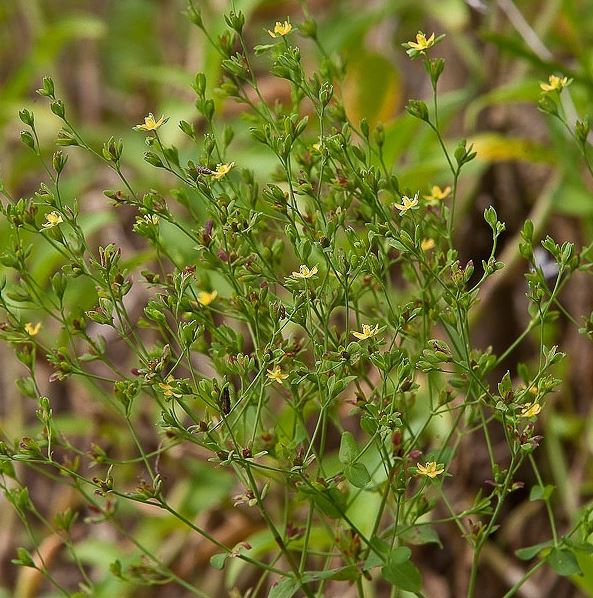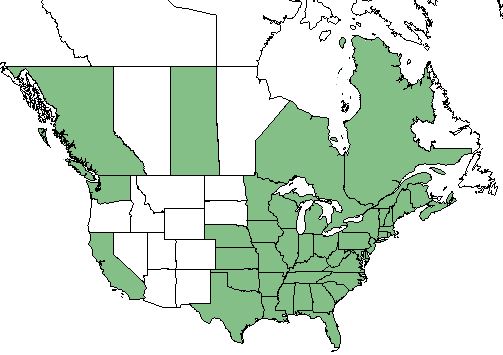Hypericum mutilum
Common name: dwarf St. John's-wort,[1] southern dwarf St. John's-wort, common dwarf St. John's-wort[2]
| Hypericum mutilum | |
|---|---|

| |
| Photo by John B | |
| Scientific classification | |
| Kingdom: | Plantae |
| Division: | Magnoliophyta - Flowering plants |
| Class: | Magnoliopsida - Dicots |
| Order: | Theales |
| Family: | Clusiaceae |
| Genus: | Hypericum |
| Species: | H. mutilum |
| Binomial name | |
| Hypericum mutilum L | |

| |
| Natural range of Hypericum mutilum from USDA NRCS Plants Database. | |
Contents
Taxonomic Notes
Synonyms: Hypericum mutilum ssp. latisepalum (Fernald) N. Robson; H. mutilum ssp. mutlum[2]
Varieties: Hypericum mutilum L. var. latisepalum Fernald; Hypericum mutilum L. var. mutilum[2]
Description
H. mutilum is an annual/perennial forb/herb native to Canada and North America and introduced in Hawaii.[1]
Distribution
H. mutilum is found in the eastern half of United States, Washington, California, the British Columbia, Saskatchewan, Ontario, and Quebec regions of Canada; and Hawaii.[1] It is also found in Central and South America as well as Europe.
H. mutilum var. latisepalum occurs from southeastern South Carolina south to peninsular Florida and west to Texas. Comparatively, H. mutilum var. mutilum is more widespread.[2] This variant's range extends from Newfoundland and Quebec to southern Florida and central Texas. It is scattered, likely as an adventive, throughout western North America, Central and South America, and Europe.[2]
Ecology
Habitat
H. mutilum is found in bogs, fens, marshes, shores, and other wet habitats, and H. mutilum var. latisepalum specifically can be found in marshes and other wet habitats.[2] Specimens have been collected from shallow water of marsh area, moist loamy sand, floodplains, small pond depressions, and riparian areas.[3] It grows best in partial shade.[4] The USDA Natural Resources Conservation Service lists this plant as a facultative wetland species that is most often found in wetland habitats, but can occasionally be found in non-wetland habitats as well.[1] A study on old-field succession of abandoned agriculture sites in central New Jersey observed Hypericum mutilum to grow seedlings during the early successional first year of agricultural abandonment.[5]
Associated species include Boehmeria sp., Triadenum sp., Carex longii, Eryngium prostratum, Paspalum sp., Chasmanthium sp., and Rhynchospora sp.[3]
Phenology
Generally, H. mutilum flowers from June until October.[2] It has been observed flowering in April through July.[6]
Seed bank and germination
One population of this plant was discovered at high densities at a constructed wetland site on a Delaware River tidal freshwater wetland.[7] Another study found this species as a component of the seed bank at the bay habitat type on the Savannah River Site in South Carolina.[8] Regeneration or germination mainly occurs in non-flooded and exposed substrates rather than flooded substrates at sites on coastal plain pondshores in New York.[9]
Fire ecology
H. mutilum is not fire resistant and has low fire tolerance.[1]
Conservation, cultivation, and restoration
This species is considered vulnerable in Quebec, imperiled in Wisconsin, critically imperiled in Nebraska and Prince Edward Island, and an exotic species in British Columbia.[10]
Cultural use
Photo Gallery
References and notes
- ↑ 1.0 1.1 1.2 1.3 1.4 USDA Plant Database https://plants.usda.gov/core/profile?symbol=HYMU
- ↑ 2.0 2.1 2.2 2.3 2.4 2.5 2.6 Weakley, A.S. 2020. Flora of the Southeastern United States. Edition of 20 October 2020. University of North Carolina at Chapel Hill, Chapel Hill, North Carolina.
- ↑ 3.0 3.1 URL: http://herbarium.bio.fsu.edu. Last accessed: June 2018. Collectors: Loran C. Anderson, V. Craig, H. Roth, Bill Boothe, marcia Boothe, Leon Neel, R.K. Godfrey, R. Komarek, J.M. Kane, Annie Schmidt. States and counties: Florida (Gadsden, Leon, Liberty, Wakulla) Georgia (Thoms, Grady) South Carolina (Georgetown)
- ↑ [[1]] Lady Bird Johnson Wildflower Center. Accessed: May 28, 2019
- ↑ Leck, M. A. and C. F. Leck (1998). "A ten-year seed bank study of old field succession in central New Jersey." The Journal of the Torrey Botanical Society 125(1): 11-32.
- ↑ Nelson, G. PanFlora: Plant data for the eastern United States with emphasis on the Southeastern Coastal Plains, Florida, and the Florida Panhandle. www.gilnelson.com/PanFlora/ Accessed: 22 MAY 2018
- ↑ Leck, M. A. and C. F. Leck (2005). "Vascular plants of a Delaware River tidal freshwater wetland and adjacent terrestrial areas: Seed bank and vegetation comparisons of reference and constructed marshes and annotated species list." Journal of the Torrey Botanical Society 132: 323-354.
- ↑ Poiani, K. A. and P. M. Dixon (1995). "Seed banks of Carolina bays: potential contributions from surrounding landscape vegetation " American Midland Naturalist 134: 140-154
- ↑ Schneider, R. (1994). "The role of hydrologic regime in maintaining rare plant communities of New York's coastal plain pond shores." Biological Conservation 68: 253-260.
- ↑ [[2]] NatureServe Explorer. Accessed: May 28, 2019